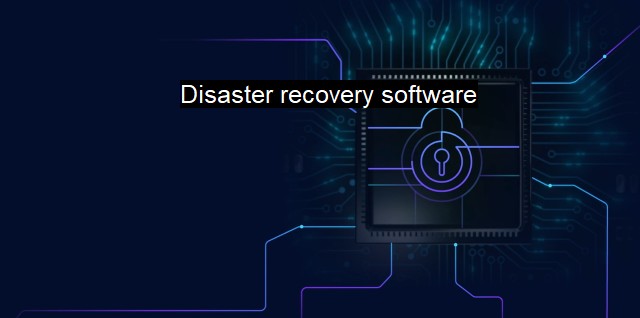What is Disaster recovery software?
The Vital Role of Disaster Recovery Software in Cybersecurity and Antivirus: Protecting Organizations from Virtual and Physical Disasters
Disaster recovery software is a crucial tool for protecting organizations from both physical and virtual disasters. disaster recovery software plays a key role in ensuring business continuity and reducing downtime in the event of a data breach or cyber-attack.What is Disaster Recovery Software?
Disaster recovery software, also known as backup and recovery software, is a type of software that helps an organization to maintain business continuity and recover from data loss in the event of a natural or man-made disaster, hardware failure, or malicious attack. Disaster recovery software works by creating a backup of important data and storing it in a secure location. In the event of a disaster, this backup can be used to restore the data quickly, reducing downtime and limiting the impact on the organization.
Disaster recovery software can be either on-premises or cloud-based. On-premises disaster recovery software stores backups in a local or remote location, such as a data center or a dedicated disaster recovery site. Cloud-based disaster recovery software stores backups in the cloud, either in the provider's data center or a third-party provider's data center. Cloud-based solutions can be less expensive and simpler to implement than on-premises solutions, but they may not be suitable for all organizations.
Why is Disaster Recovery Software Important for Cybersecurity and Antivirus?
Disaster recovery software has become increasingly important in the context of cybersecurity and antivirus due to the growing threat of cyber-attacks and the resulting data breaches, ransomware attacks, and other forms of malware or hacking. Cybersecurity experts agree that no organization can be fully protected from cyber-attacks, and that the best defense strategy is a combination of prevention and remediation. Disaster recovery software is a crucial component of such a strategy because it allows an organization to recover from a cyber-attack quickly and with minimal loss of data.
When a cyber-attack occurs, one of the first steps a cybercriminal may take is to encrypt or delete important files in order to make them inaccessible to the organization and demand a ransom payment for their return. This can cause significant operational disruption, financial loss, and reputational damage. Disaster recovery software can help an organization to recover these files quickly by restoring them from a backup copy.
Similarly, disaster recovery software can help an organization to recover from other types of data loss, such as accidental deletions, hardware failure, or natural disasters. This can reduce downtime and prevent employees from losing work or productivity while waiting for the IT department to fix the issue.
Disaster recovery software can also help an organization to meet regulatory and compliance requirements, such as HIPAA, PCI-DSS, or GDPR. Many of these regulations require organizations to have backup and recovery procedures in place to protect sensitive data and customer information. Failure to comply with these requirements can result in fines, lawsuits, and other legal repercussions.
Conclusion
disaster recovery software is a critical tool for organizations in the context of cybersecurity and antivirus. It helps to maintain business continuity, reduce downtime, and protect against data loss in the event of a disaster, cyber-attack, or other form of data breach. Organizations should carefully evaluate their disaster recovery needs and choose a solution that is suitable for their own unique requirements. A combination of on-premises and cloud-based disaster recovery solutions may be the best strategy for many organizations. With the right disaster recovery software in place, organizations can have greater peace of mind knowing that they are prepared for the unexpected.

Disaster recovery software FAQs
What is disaster recovery software and how does it work?
Disaster recovery software is a type of software that is designed to provide backup and recovery support for critical systems and data in the event of a disaster. It works by backing up important files and data and storing them in secure locations, so that they can be easily recovered in case of a disaster.What are the key features of a good disaster recovery software?
A good disaster recovery software should have the following features: 1. Automated backup and recovery 2. Regular testing of backup systems 3. Secure storage of backup data 4. Fast recovery times 5. Scalability to meet business needs 6. Integration with other cybersecurity and antivirus systemsWhat are the benefits of using disaster recovery software in conjunction with cybersecurity and antivirus software?
Disaster recovery software can provide several benefits when used in conjunction with cybersecurity and antivirus software, such as: 1. Improved data protection and security 2. Reduced downtime and business disruption 3. Faster recovery times 4. Protection against data loss and corruption 5. Increased reliability and availability of critical systems and dataIs disaster recovery software necessary for small businesses?
Yes, disaster recovery software is essential for small businesses, as they are often more vulnerable to cybersecurity threats and may have limited resources to manage a disaster recovery plan. In the event of a disaster, having a backup and recovery plan in place can save a small business from significant financial losses and reputational damage.| | A | | | B | | | C | | | D | | | E | | | F | | | G | | | H | | | I | | | J | | | K | | | L | | | M | |
| | N | | | O | | | P | | | Q | | | R | | | S | | | T | | | U | | | V | | | W | | | X | | | Y | | | Z | |
| | 1 | | | 2 | | | 3 | | | 4 | | | 7 | | | 8 | | |||||||